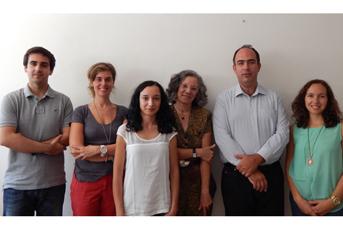Associação Portuguesa de Investigação em Cancro
Efeitos da metoxiamina em células de cancro de mama expostas à doxorrubicina
Efeitos da metoxiamina em células de cancro de mama expostas à doxorrubicina

O trabalho intitulado «Differential effects of methoxyamine on doxorubicin cytotoxicity and genotoxicity in MDA-MB-231 human breast cancer cells» insere-se no âmbito do estudo de inibidores da reparação de lesões do DNA. Estes compostos têm sido desenvolvidos como potenciais agentes terapêuticos com o objectivo de aumentar a eficácia da quimioterapia. Neste artigo, avaliámos os efeitos da metoxiamina na citotoxicidade e genotoxicidade induzida pela doxorrubicina em células de cancro de mama MDA-MB-231. A metoxiamina é um inibidor indirecto da enzima APE1 envolvida na reparação por excisão de bases (BER). Os resultados obtidos apontam para um aumento das lesões de DNA induzidas pela doxorrubicina na presença da metoxiamina, sugerindo um papel deste inibidor da BER como potenciador dos efeitos genotóxicos da doxorrubicina, mas não dos efeitos citotóxicos.
Autores e afiliações:
Patrícia S. Guerreiro1, Ana Sofia Fernandes2,1, João G. Costa1,2, Matilde Castro1, Joana P. Miranda1 e Nuno G. Oliveira1
1. Research Institute for Medicines and Pharmaceutical Sciences (iMed.UL), Faculty of Pharmacy, University of Lisbon, Av. Prof. Gama Pinto, 1649-003 Lisbon, Portugal
2. CBIOS, Universidade Lusófona Research Center for Biosciences and Health Technologies, Campo Grande 376, 1749-024 Lisbon, Portugal
Abstract:
Pharmacological inhibition of DNA repair is a promising approach to increase the effectiveness of anticancer drugs. The chemotherapeutic drug doxorubicin (Dox) may act, in part, by causing oxidative DNA damage. The base excision repair (BER) pathway effects the repair of many DNA lesions induced by reactive oxygen species (ROS). Methoxyamine (MX) is an indirect inhibitor of apurinic/apyrimidinic endonuclease 1 (APE1), a multifunctional BER protein. We have evaluated the effects of MX on the cytotoxicity and genotoxicity of Dox in MDA-MB-231 metastatic breast cancer cells. MX has little effects on the viability and proliferation of Dox-treated cells. However, as assessed by the cytokinesis-block micronucleus assay (CBMN), MX caused a significant 1.4-fold increase (P< 0.05) in the frequency of micronucleated binucleated cells induced by Dox, and also altered the distribution of the numbers of micronuclei. The fluorescence probe dihydroethidium (DHE) indicated little production of ROS by Dox. Overall, our results suggest differential outcomes for the inhibition of APE1 activity in breast cancer cells exposed to Dox, with a sensitizing effect observed for genotoxicity but not for cytotoxicity.




